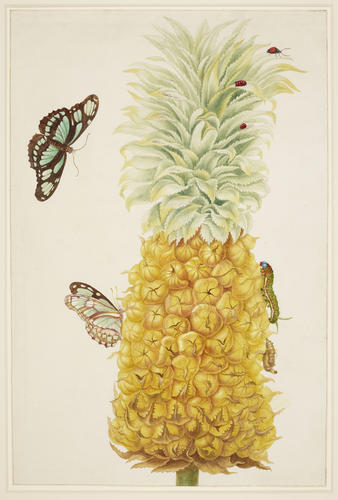-
1 of 253523 objects
Ripe Pineapple with Dido Longwing Butterfly 1702-03
Watercolour and bodycolour with gum arabic over lightly etched outlines on vellum | 43.5 x 28.8 cm (vellum sheet) | RCIN 921154

Maria Sibylla Merian (1647-1717)
Ripe Pineapple with Dido Longwing Butterfly 1702-03
-
A watercolour of a ripe Pineapple (Ananas comosus), with the life cycle of a Dido Longwing Butterfly (Philaethria dido). This is an adaptation of plate 2 of Merian's Metamorphosis Insectorum Surinamensium. Merian noted that the Dido Longwing was 'a very beautiful butterfly' and that the wine made from pineapples had 'an unsurpassable flavour' [Translation from Elizabeth Rücker and William T. Stearn, Maria Sibylla Merian in Surinam, London 1982].
Maria Sibylla Merian was the daughter of the printmaker Matthias Merian, and the step-daughter of the still-life painter Jacob Marrel. She was a talented artist, who was trained in flower painting by Marrel. From an early age, she was fascinated by insects and their life cycles, and undertook research into the phenomenon of metamorphosis, which was then only partially understood. She published her findings in a series of books, illustrated with beautifully-composed plates in which each insect life-cycle was illustrated on the appropriate food plant. In 1699, having encountered exotic insects in the cabinets of natural history collectors in Amsterdam, Merian and her younger daughter Dorothea set sail for Suriname, in South America, which was then a Dutch colony. There, they studied the life cycles of Surinamese insects until their return to Europe in 1701. Merian published her Surinamese research as the Metamorphosis Insectorum Surinamensium (The Metamorphosis of the Insects of Suriname) in 1705. The book was very well-received, and by her death Merian was well-regarded throughout Europe as both an entomologist and an artist.
This is one of a set of luxury versions of the plates from Merian's Metamorphosis Insectorum Surinamensium, published in Amsterdam in 1705. To make these versions, Merian (probably assisted by her daughters) appears to have inked sections of each etched plate and run it through the press to create a partial print. While the ink of that print was still wet, she placed a sheet of vellum against it, transferring a reverse image onto the vellum. This ‘counterproof’ was then worked up and coloured by hand. The Royal Collection plates are partially printed and partially hand-drawn, the printing mainly being used for the insects. As Merian was only transferring selected areas of the printed image, she could vary the arrangements of the plates, with the positions of the butterflies and moths subtly altered to create unique compositions.
A preparatory drawing of the butterflies, originally in Merian's study book and probably sold by the artist in 1706, is now in the Germanisches Nationalmuseum, Nuremberg (Inv. no. Hz 371, see Kurt Wettengl, ed., Maria Sibylla Merian. Artist and Naturalist 1647-1717, Frankfurt 1998, cat. 85).Provenance
Dr Richard Mead (1673–1754); his sale (London, Abraham Langford, 13–16 January 1755, lot 66), where purchased by an unknown collector; sold 15 June 1768 (London, Paterson and Eve, lot 572), where purchased by Sir John Hill via Wilson; George III by c.1810
-
Creator(s)
Acquirer(s)
-
Medium and techniques
Watercolour and bodycolour with gum arabic over lightly etched outlines on vellum
Measurements
43.5 x 28.8 cm (vellum sheet)
Category
Object type(s)
Other number(s)
RL 21154Alternative title(s)
Plate 2 to Metamorphosis Insectorum Surinamensium
A ripe pineapple (Ananas comosus), the caterpillar, chrysalis and butterfly of the dido longwing (Philaetria dido) and a beetle (Chilocorus cacti)